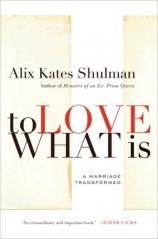Reading Group Guide
Discussion Questions
To Love What Is: A Marriage Transformed

1. One of the most unusual aspects of Alix Kates Shulman’s memoir is the fact that she and her husband did not marry each other until decades after they first fell in love. What did they mean to each other at various chapters in their lives? What aspects of their identities remained unchanged over the years? Later in life, how did they help each other grow?
2. How were you affected by Shulman’s shifting timeline? How did it reflect the way the past is often still present, through memory? What flashbacks are still very much a part of your own everyday thoughts?
3. What place do the author’s feminist sensibilities have in To Love What Is? Do you think that her devotion to her husband is in sync or in conflict with her feminism?
4. What makes Alix and Scott so compatible, despite the religious, economic, and family differences they started out with in youth and, later, their differences in sensibility and experience?
5. What does sex mean to Alix at various points in her life? How does it reflect her sense of self? What ironies lie in the flourishing, then waning, then recurring sex in her marriage to Scott?
6. Discuss Scott’s transition to life as a sculptor. How does his visual art complement Alix’s literary art? How might artists address the aftermath of brain injury differently from non-artists (as illustrated in Alix’s ability to see depth in Scott’s words, where therapists saw incoherence)? In what ways did Alix’s understanding of Scott’s true and enduring self clarify after his accident?
7. What aspects of a relationship ensure that a couple can survive even the worst crises? What equipped Alix to stay by Scott’s side, even when his injuries made him belligerent and occasionally violent? How did her feelings about commitment and relationships evolve throughout her life? What determines whether a couple can adapt to changed circumstances and “love what is,” no matter what?
8. For Alix, the use of the word “elderly” by health care workers to describe Scott was startling. This, and the sudden changes in Scott’s capacities, made her reconsider her attitude toward aging and time. How have our perceptions of aging changed in recent years? Do you define aging according to physical attributes, or do you think of it in different terms?
9. Reread the poem “Could Have,” featured in chapter six (“Could Happen”). What images of destiny and happenstance come to mind as you apply it to your own life?
10. Discuss the trip to Italy described in chapter seven (“Traveling On”). What did the journey mean to Alix and Scott, and their friends? What triumphs and setbacks did it represent?
11. As Alix and Scott return to the nubble at the close of the book, what transformations have occurred since the opening scenes there? Why was theirs a marriage transformed, rather than a marriage injured or destroyed? What aspects of their marriage are reflected in their two modes of life: one in Manhattan and the other in Maine?
12. Alix is understandably shaken by Scott’s inability to tell whether she is his wife or his mother. Do all wives and husbands take on the role of parent for their spouses to some extent? How do Scott’s injuries illuminate how our identities change or persist over time?
13. What allows Alix to finally accept the prospect of a nursing home for Scott, and to embrace the idea that female patients may line up to be courted by him? Why was it important for her to try to care for him herself? Did he fare better for those initial months and years with her than he would have in an institution?
14. What is that “dreaded event” you sometimes worry about? Do you predict that you will be a caregiver or a recipient of care if this event comes to pass? Who are the best caregivers you know? What qualities make them effective? How do you think you would handle the role of caregiver?
15. How does Shulman’s perspective in Drinking the Rain compare to the view of the world voiced in To Love What Is? What is the complete story captured in these two memoirs? Are any of these threads apparent in Shulman’s novels?
To Love What Is: A Marriage Transformed
- Publication Date: September 1, 2009
- Paperback: 192 pages
- Publisher: Farrar, Straus and Giroux
- ISBN-10: 0374532052
- ISBN-13: 9780374532055







